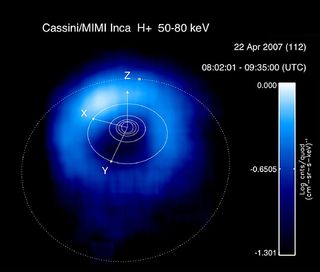Mysterious Twist Found in Saturn's Electric Ring

Aninvisible donut of trapped, hot particles surrounding Saturn is all bent out ofshape--a finding that astronomers can't yet explain.
A similar"ring current" phenomenon occurs around Earth as a relatively stabledonut when present, but new Cassini spacecraft images show Saturn's loop is alopsided mess.
"It'scurious that Saturn's ring current isn't symmetric," said Don Mitchell, anastrophysicist at Johns Hopkins University who helped examine the images beamedback to Earth. "We think the solar wind is squishing the sunward side ofthe ring current, kind of like a wind sock."
Planetswith magnetic fields can trap hot particles within their clutches to form giantelectrified clouds?the ring currents?that are invisible to the naked eye.
Earth'sring current is made of hydrogen and appears duringsolar flares. Saturn's is made largely of oxygen and is always present. Thesaturnian moon Enceladus is responsible for the electric halo, as itconsistently spewswater vapor from its depths to feed the ring current with oxygen andhydrogen ions.
Becauseoxygen is far heavier than hydrogen, Mitchell said, Saturn's ring current candistort the planet's magnetic field and make for an odd shape.
"Theheavier oxygen is like a rock on a string, stretching the magnetic field ofSaturn," Mitchell said.
Get the Space.com Newsletter
Breaking space news, the latest updates on rocket launches, skywatching events and more!
Moremysterious to Mitchell and his colleagues, however, is a "clump" ofelectrified particles within the ring that rotates insync with the planet roughly every 10 hours and 47 minutes.
Cassini'simages show the bright clump orbits Saturn between 300,000 and 634,000 miles(485,000 and 1,000,000 kilometers) away from the planet's surface, butastronomers have not yet figured out what creates it nor why it moves so quickly.
"Saturnis a big fast rotator. The clump seems loosely hooked to the planet, yetrotates with it," Mitchell said. "It may be connected with Saturn'sring current, but we just don't know. This is something we're working very hardto figure out."
StamatiosKrimigis, also an astrophsycist at Johns Hopkins who examined the images, ispresenting them Thursday at the European Planetary Science Congress in Potsdam, Germany.
- The Top 10 Strangest Things in Space
- VIDEO: Enceladus - 'Cold Faithful'
- GALLERY: Cassini's Latest Discoveries
Join our Space Forums to keep talking space on the latest missions, night sky and more! And if you have a news tip, correction or comment, let us know at: community@space.com.
Dave Mosher is currently a public relations executive at AST SpaceMobile, which aims to bring mobile broadband internet access to the half of humanity that currently lacks it. Before joining AST SpaceMobile, he was a senior correspondent at Insider and the online director at Popular Science. He has written for several news outlets in addition to Live Science and Space.com, including: Wired.com, National Geographic News, Scientific American, Simons Foundation and Discover Magazine.
